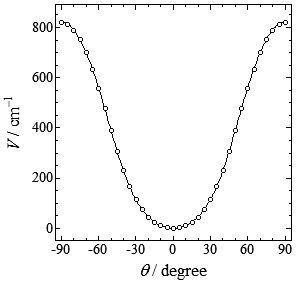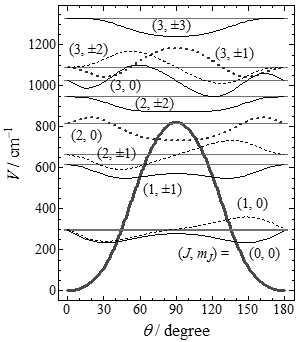
Fig. 4-1. ω4 bending vibration of the transition state of C2(X) + H2 reaction.
Sample problem 3: c2h2TSbendHH

bx1fitPlls input: c2h2TSbendHH.fit
'#' is a title line and next
non-blank line is an output option control.# H2 internal rotation of C2(X) + H2 TS outputOption powerSerieswhich tells bx1fitPlls to generate input file for bx1S2HRsol. The program bx1S2HRsol requires potential function in the power series of z = cos(θ).
optFuncs{
const
pow 2
pow 4
pow 6
pow 8
pow 10
pow 12
}
tells bx1fitPlls that the regression function is:
V = a0
+ a1 z2
+ a2 z4
+ a3 z6 + ...
+ a6 z12.
xyTable{
1. 0.
0.996195 2.596
0.984808 10.579
0.965926 24.539
0.939693 45.493
0.906308 74.887
0.866025 114.480
0.819152 165.960
0.766044 230.224
0.707107 306.259
0.642788 390.305
0.573576 476.646
0.5 559.638
0.422618 634.982
0.342020 699.740
0.258819 751.938
0.173648 790.227
0.087156 813.656
0. 821.564
}
Each line between block header 'xyTable{' and terminator '}'
defines a datum point with the simple two-column format
as explained in the first sample.
Figure 4-2 shows the potential energy curve along θ.

continue{
maxJ 70 ! maximum J
rotConst 54.0077 ! for H2 / cm-1
nuSpinSt 2 1 3 ! period = 2, alternation is 1,3,1,3,... (H2)
!rotConst 27.1731 ! for D2 / cm-1
!nuSpinSt 2 2 1 ! period = 2, alternation is 2,1,2,1,... (D2)
!symNumbr 2 ! might be specified instead of nuSpinSt
!
!output all
!
tempList 290 300 350 400 450 500
}
Any line in the block is copied to the bx1S2HRsol input,
'c2h2TSbendHH.inp'.
bx1fitPlls console output
bx1S2HRsol input: c2h2TSbendHH.inp
c2h2TSbendHH.fit:# H2 internal rotation of C2(X) + H2 TS
continue
block contents:maxJ 70 ! maximum J rotConst 54.0077 ! for H2 / cm-1 nuSpinSt 2 1 3 ! period = 2, alternation is 1,3,1,3,... (H2) !rotConst 27.1731 ! for D2 / cm-1 !nuSpinSt 2 2 1 ! period = 2, alternation is 2,1,2,1,... (D2) !symNumbr 2 ! might be specified instead of nuSpinSt ! !output all ! tempList 290 300 350 400 450 500i)
'maxJ', is the maximum rotational quantum number
in the expansion basis.'rotConst' sets the rotational
constant ( = 'nuSpinSt' or 'symNumber'
are similar to the previous sample.output, tempList, etc.
can be used similarly to the previous two samples.
potPars{ ! potential parameters
0 821.67758
2 -1053.3809
4 242.56772
6 -1654.8564
8 3764.0737
10 -2852.4891
12 732.34203
}
bx1S2HRsol output
'c2h2TSbendHH_eigen_values.csv' (eigen values) and
'c2h2TSbendHH_part_funcs.csv' (partition functions).
Optionally, by using the output key in the input,
'c2h2TSbendHH_eigen_vectors_mJ####_p%%.csv' (eigen vectors)
and 'c2h2TSbendHH_eigen_funcs_mJ####_p%%.csv' (eigen functions)
will be also created. Here, '####' is the mJ
quantum number and '%%' is the page number.

| 10000/T | T | Q | Qz |
| 34.482759 | 290 | 0.3478741 | 1.4893972 |
| 33.333333 | 300 | 0.3750047 | 1.5295799 |
| 28.571429 | 350 | 0.52207593 | 1.7420066 |
| 25 | 400 | 0.68661265 | 1.9706678 |
| 22.222222 | 450 | 0.86660431 | 2.2123024 |
| 20 | 500 | 1.0602155 | 2.4644241 |